Environmental Change in the Agro-Pastoral Transitional Zone, Northern China: Patterns, Drivers, and Implications
Abstract
:1. Introduction
2. Data and Methods
2.1. Overview of the Research Area
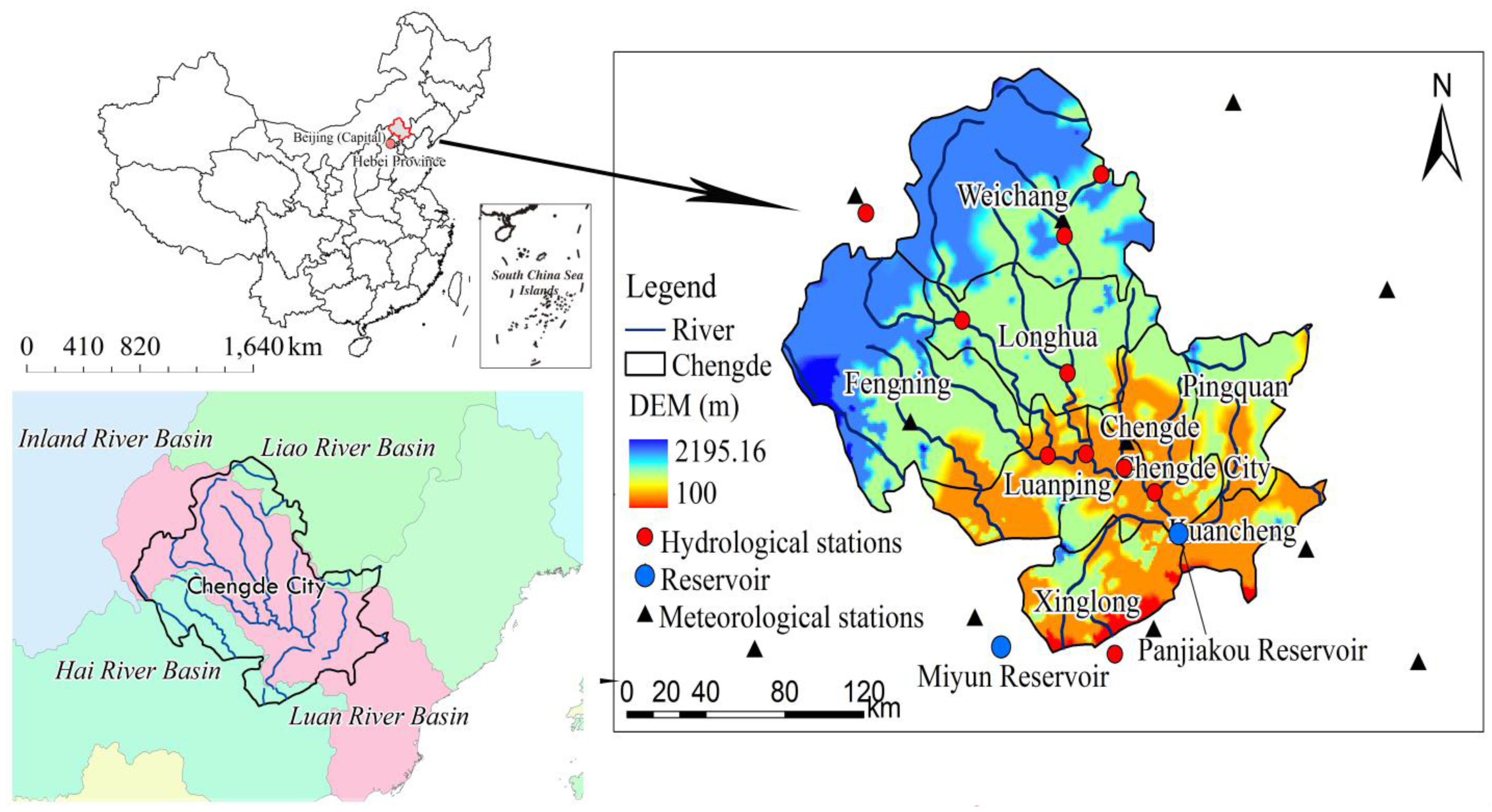
2.2. Data and Processing
| Data Types | Dataset Name and Specific Information | Source |
|---|---|---|
| Basic geographic information | Administrative map (1:4 million-scale) | The National Geomatics Center of China [19] |
| The Shuttle Radar Topography Mission (SRTM) digital elevation model (DEM) (resolution:90 m) | Consultative Group on International Agricultural Research-Consortium for Spatial Information (CGIAR-CSI) [20] | |
| River and lake system atlas (1:1 million-scale) | The National Geomatics Center of China [19] | |
| Hydrological and meteorological data | Annual water discharge and sediment load in six hydrological stations from late 1950s to 2002 | [21,22] |
| Daily meteorological data in twelve meteorological stations during 1956–2011 | National Meteorological Data Sharing Service System [23] | |
| Remote sensing image | GIMMS NDVI3g dataset from NOAA’s AVHRR sensors during 1982 to 2012 (resolution: 8 km × 8 km) | National Aeronautics and Space Administration (NASA) [24] |
| Land use maps in 1985, 2000, and 2010 (1:0.1 million-scale) | Data Center for Resources and Environmental Sciences, Chinese Academy of Sciences (RESDC) (http://www.resdc.cn) [25] | |
| Environmental monitoring data | Monthly water quality record of 17 monitoring stations from late 1980s to early 2000s Annual air and water quality records of Chengde city and Hebei Province during 2000–2012 | [22] |
| [26,27] | ||
| The social and economic data | Statistical yearbook for Chengde city | Bureau of Statistics in Hebei Province, China |
2.3. Methods
2.3.1. Indicator System for Environmental Change Assessment
| Assessment Projects | Indicators | Unit | Assessment Method |
|---|---|---|---|
| Water resources | Streamflow | m3 | Observational record |
| Water environment | Sediment load | 104 t | Observational record |
| Pollutant concentration: COD, NH3-H, MnO4−, volatile phenol | mg/L | ||
| Pollutant emission: COD, NH3-H | t/km2 | ||
| Other indicators: BOD, total hardness | mg/L | ||
| Vegetation activity | NDVI | Dimensionless | GIMMS NDVI3g dataset |
| Atmospheric environment | Pollutant concentration: PM2.5 | μg/m3 | Observational record |
| Pollutant emission: SO2, NOx | mg/L | ||
| Dusthaze days | day |
2.3.2. Mann–Kendall Trend Detection
2.3.3. Mann–Kendall Change-Point Analysis
2.3.4. Evapotranspiration Estimation with the FAO Penman–Monteith Equation
2.3.5. Estimating the Impact of Climate Variability on Streamflow
2.3.6. Vegetation Growth Change and Trend Estimation
2.3.7. Correlation Analysis between Vegetation Cover and Climatic Factor
3. Results
3.1. Climatic Change
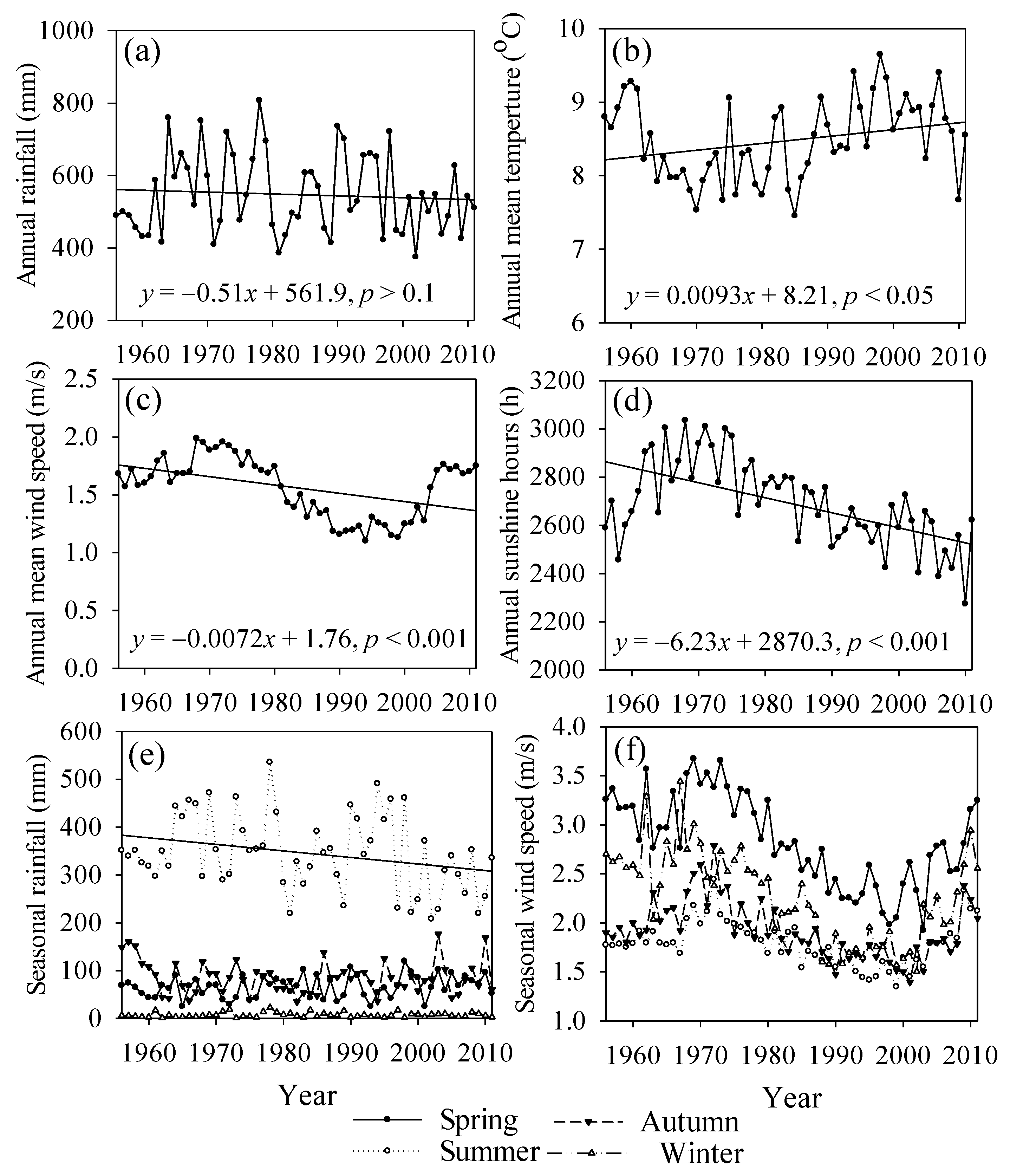
3.2. Land Use/Land Cover Change
| Types | Percent of Area and Change (%) | |||||
|---|---|---|---|---|---|---|
| 1985 | 2000 | 2010 | 1985–2000 | 2000–2010 | 1985–2010 | |
| Residential areas | 2.5 | 3.8 | 3.9 | 1.3 | 0.2 | 1.4 |
| Farmland | 16.9 | 18.7 | 18.5 | 1.8 | −0.1 | 1.6 |
| Woodland | 65.2 | 60.2 | 60.2 | −5.0 | 0.0 | −5.0 |
| Grassland | 13.9 | 14.8 | 14.8 | 0.9 | 0.0 | 0.9 |
| Desert | 0.0 | 0.6 | 0.6 | 0.6 | 0.0 | 0.6 |
| Water bodies and wetland | 1.1 | 1.4 | 1.3 | 0.3 | 0.0 | 0.2 |
| Unused land | 0.4 | 0.5 | 0.5 | 0.1 | 0.0 | 0.1 |
3.3. Water Resources Change and Attribution
3.3.1. Trend and Change Point in Annual Streamflow

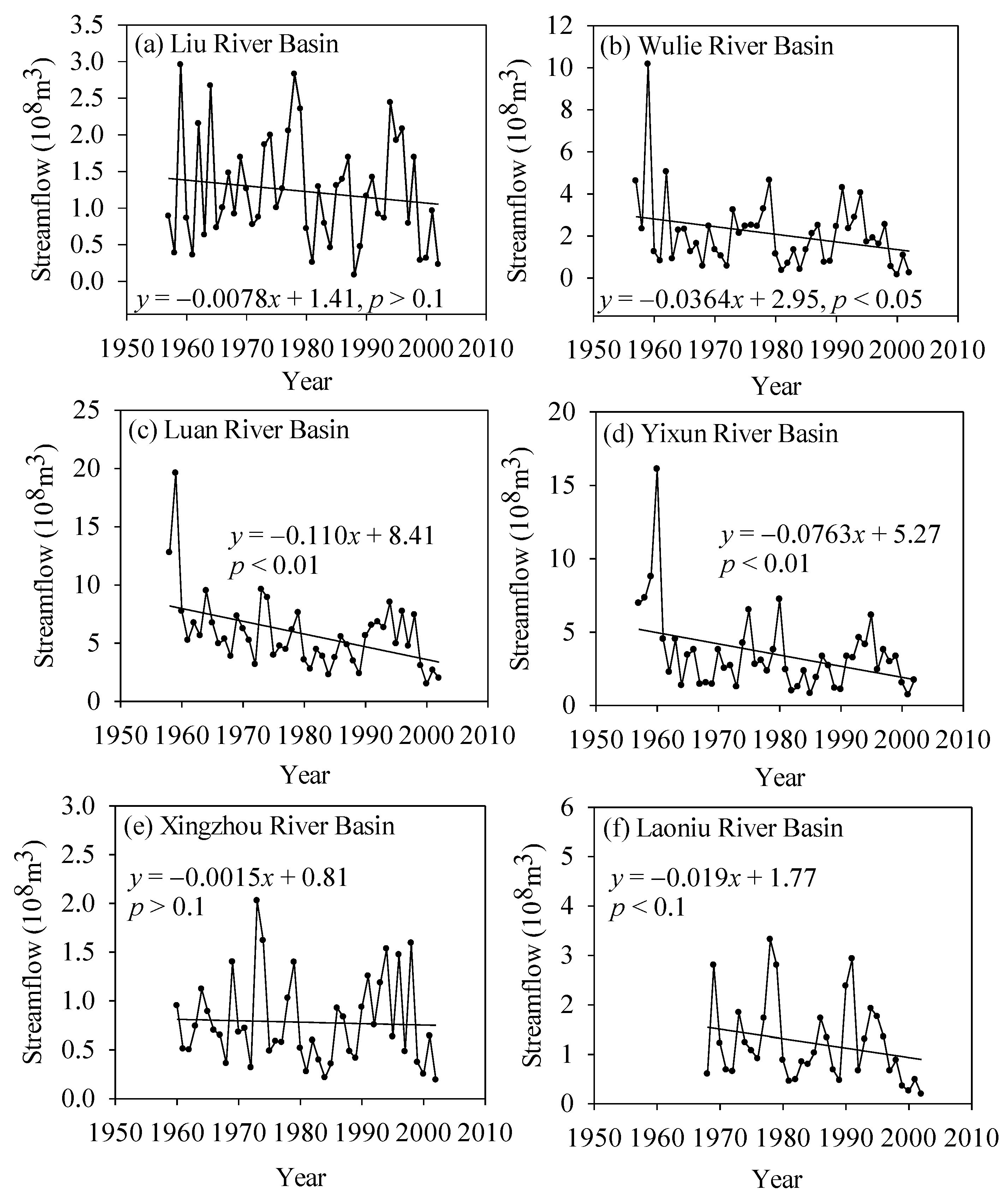
3.3.2. Attribution of Water Resources Change
| Item | ΔQ | ΔQclim | ΔQhum |
|---|---|---|---|
| Quantity/mm | 61.3 | 20.3 | 40.9 |
| Contribution rate | 100% | 33.2% | 66.8% |
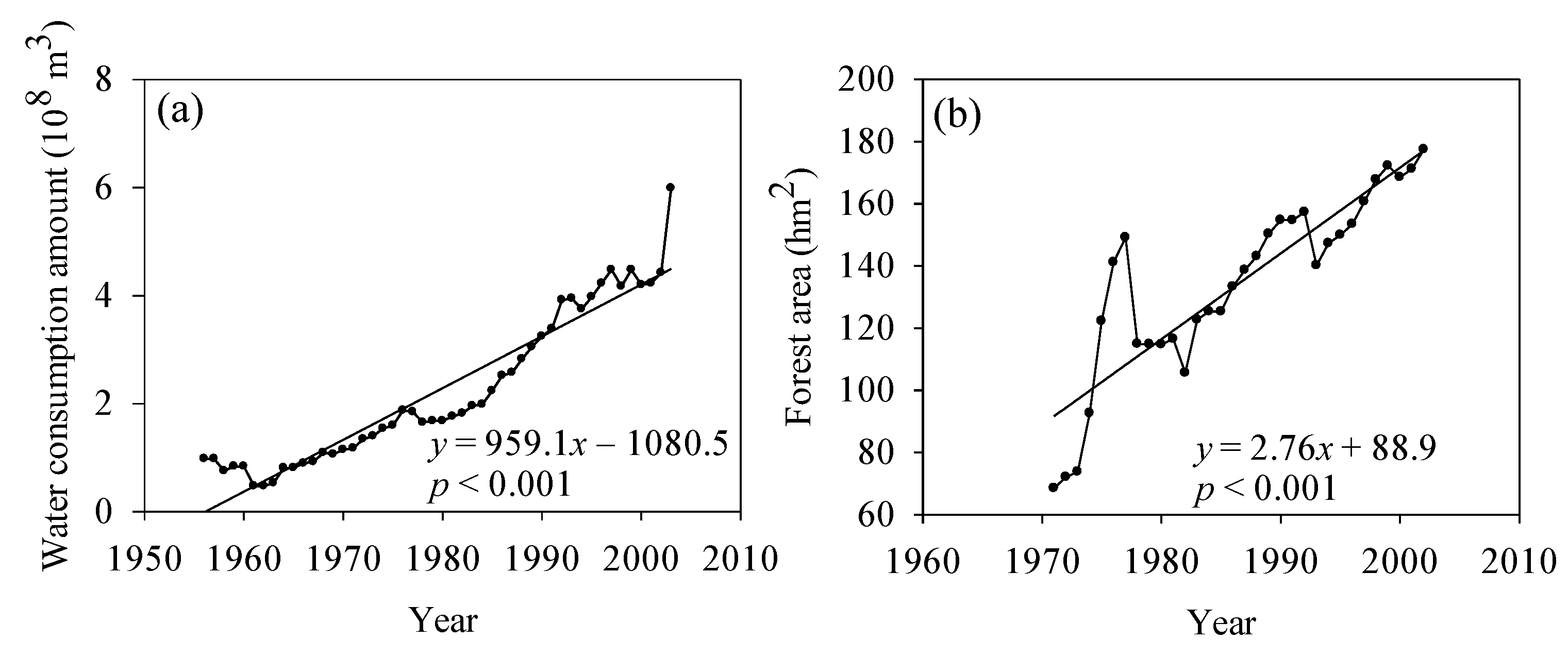
3.4. Water Environment Change and Attribution
3.4.1. Water Environment Change
| Basin | Station | Total Hardness | MnO4− | NH3-N | BOD | Volatile Phenol |
|---|---|---|---|---|---|---|
| Luan River | Guojiatun | ↑ | — | — | ↓ | — |
| Luan River | Sandaohezi | — | — | — | ↓ | — |
| Luan River | Shangbancheng | ↑ | ↑ | ↑ | ↓ | — |
| Luan River | Wulongji | ↑ | — | ↑ | ↓ | — |
| Yixun River | Weichang | — | — | ↑ | — | ↑ |
| Yixun River | Miaogong Reservoir | ↑ | ↑ | ↑ | ↓ | — |
| Yixun River | Longhua | ↑ | ↓ | — | — | ↓ |
| Yixun River | Hanjiaying | ↑ | — | ↑ | ↓ | — |
| Wulie River | Chengde | ↑ | ↑ | ↑ | ↓ | ↑ |
| Laoniu River | Xiabancheng | — | ↓ | — | — | — |
| Liu River | Xinglong | — | ↑ | ↑ | ↓ | — |
| Liu River | Liyingyi | ↑ | ↓ | — | — | — |
| Pu River | Pingquan | — | — | ↑ | ↓ | ↑ |
| Pu River | Kuancheng | — | — | — | ↓ | — |
| Sa River | Lanqiying | — | — | — | ↓ | — |
| Chao River | Dage | ↑ | — | ↑ | — | — |
| Chao River | Daiying | — | — | — | ↓ | — |
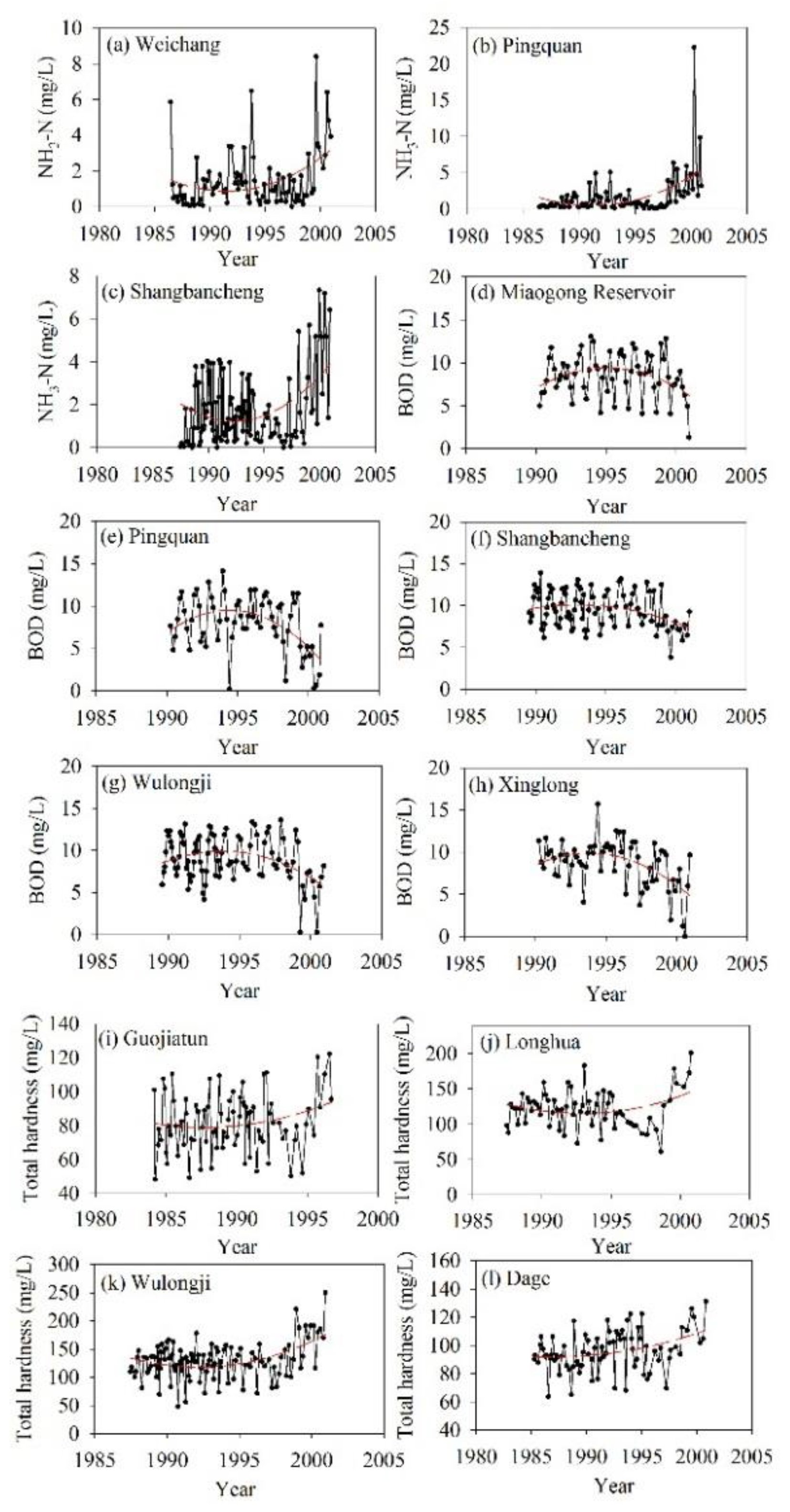

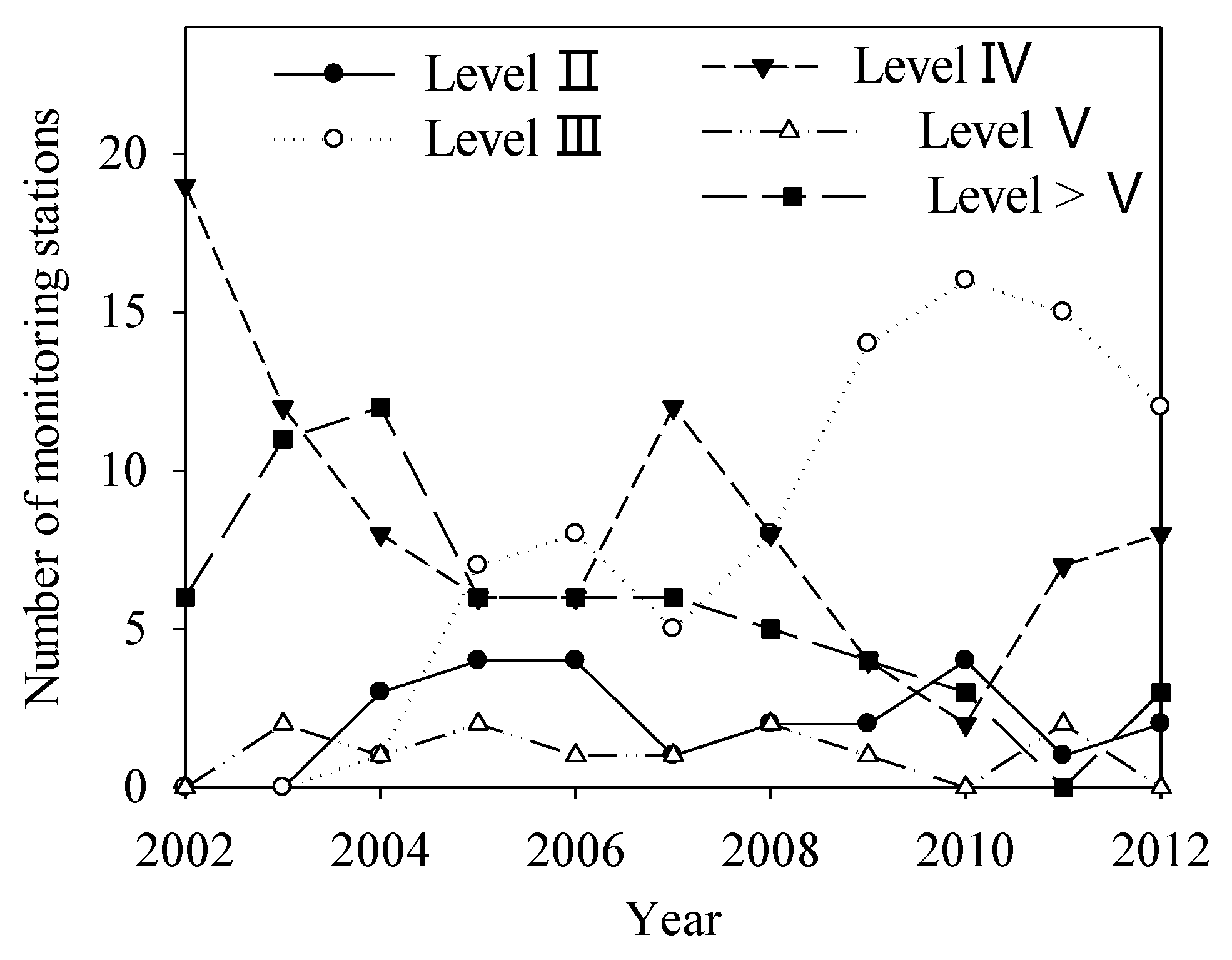
3.4.2. Attribution of Water Environment Change
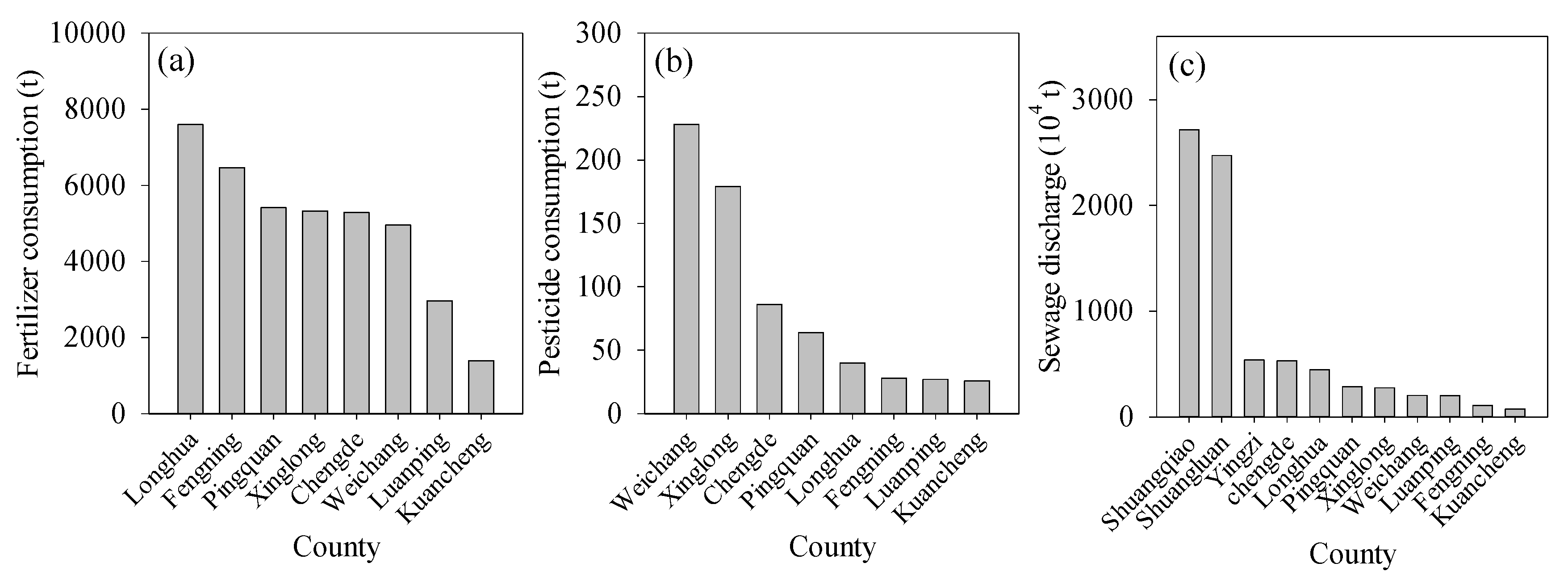
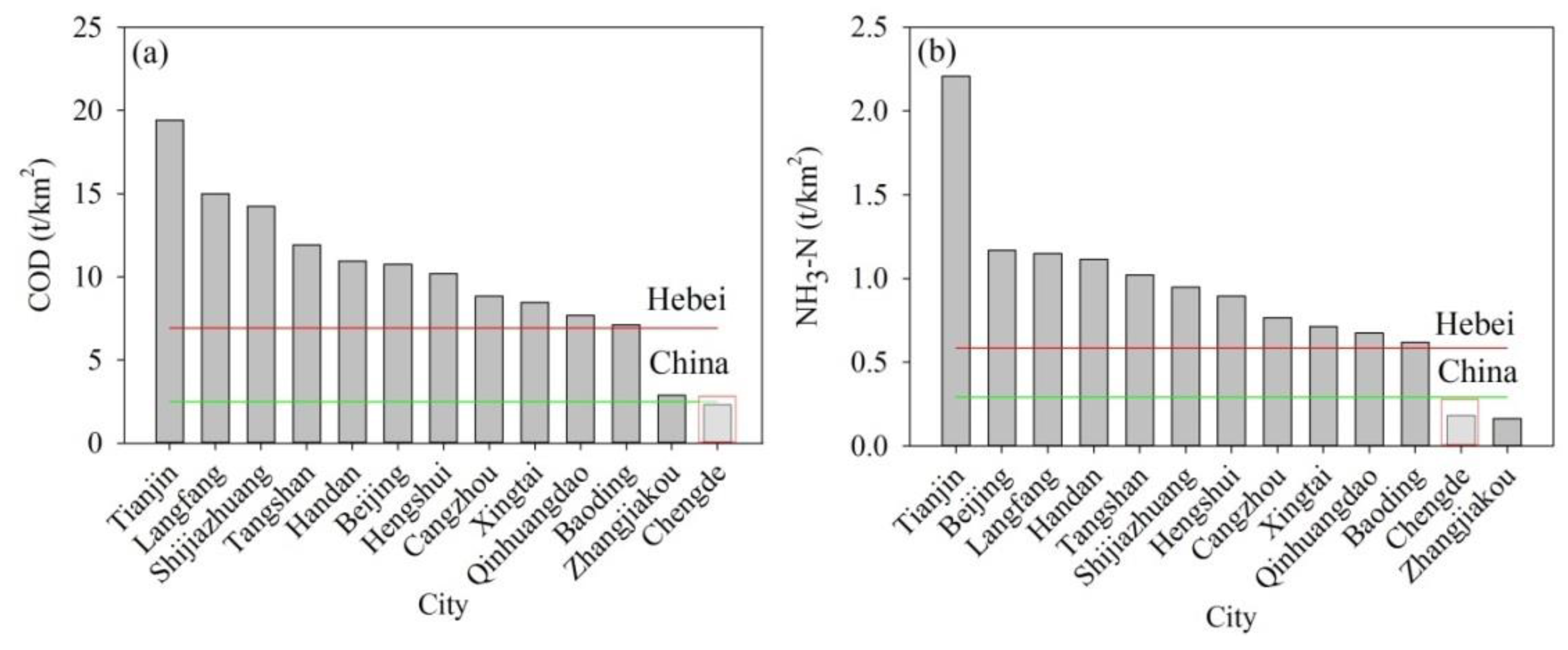
3.4.3. Soil Loss (Sediment Load) Change and Attribution
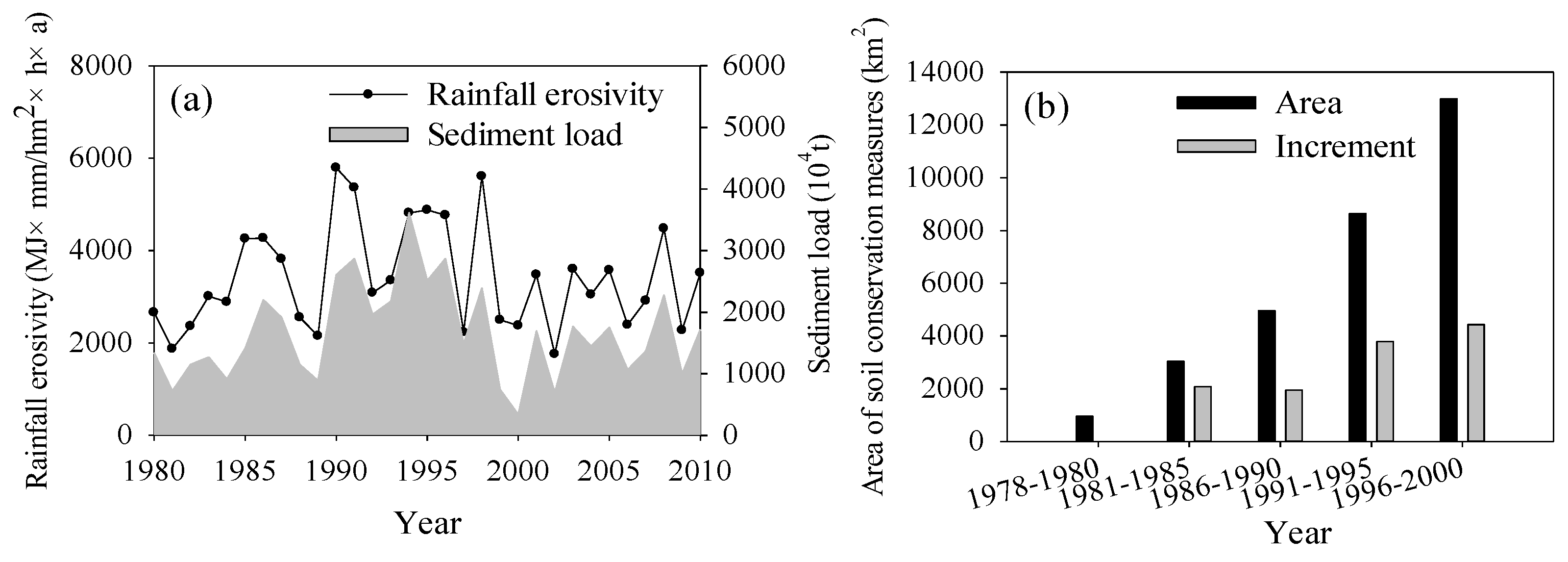
3.5. Atmospheric Environment Change and Attribution
3.5.1. Atmospheric Environment Change
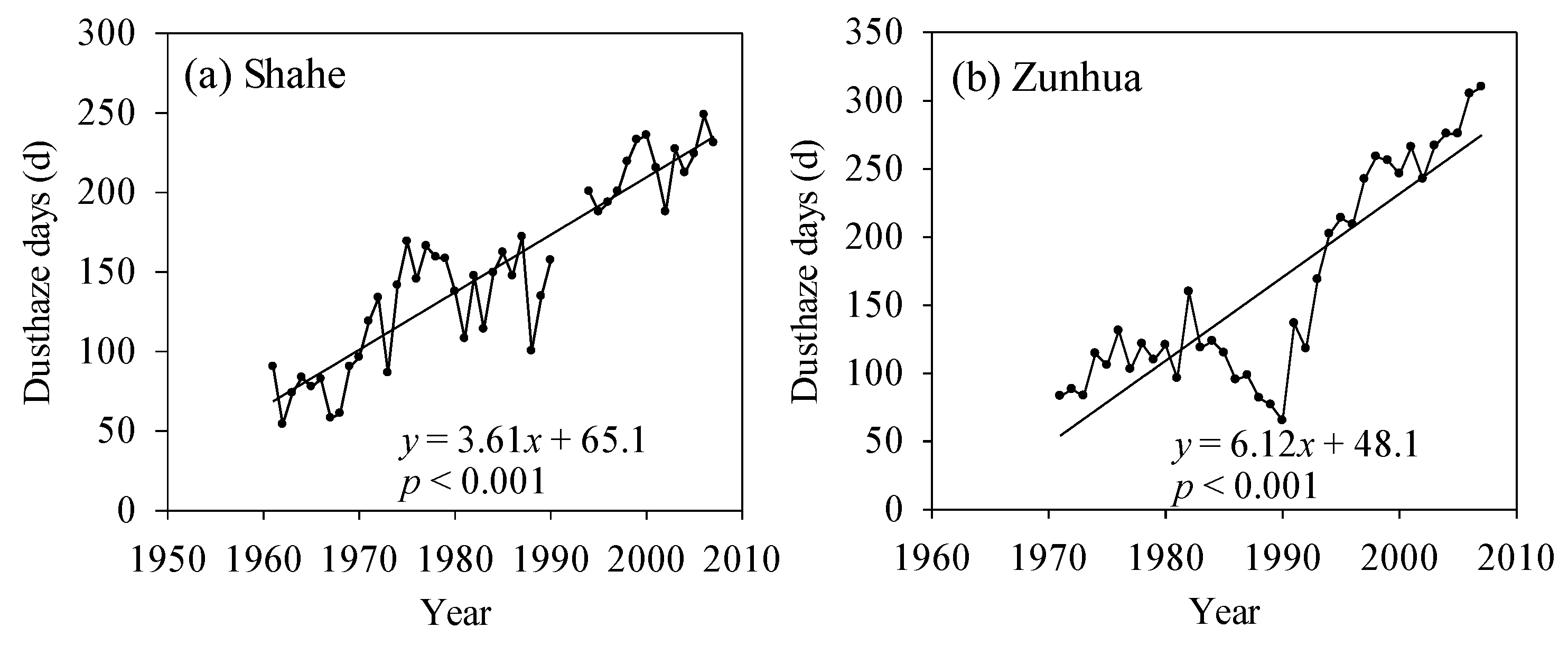
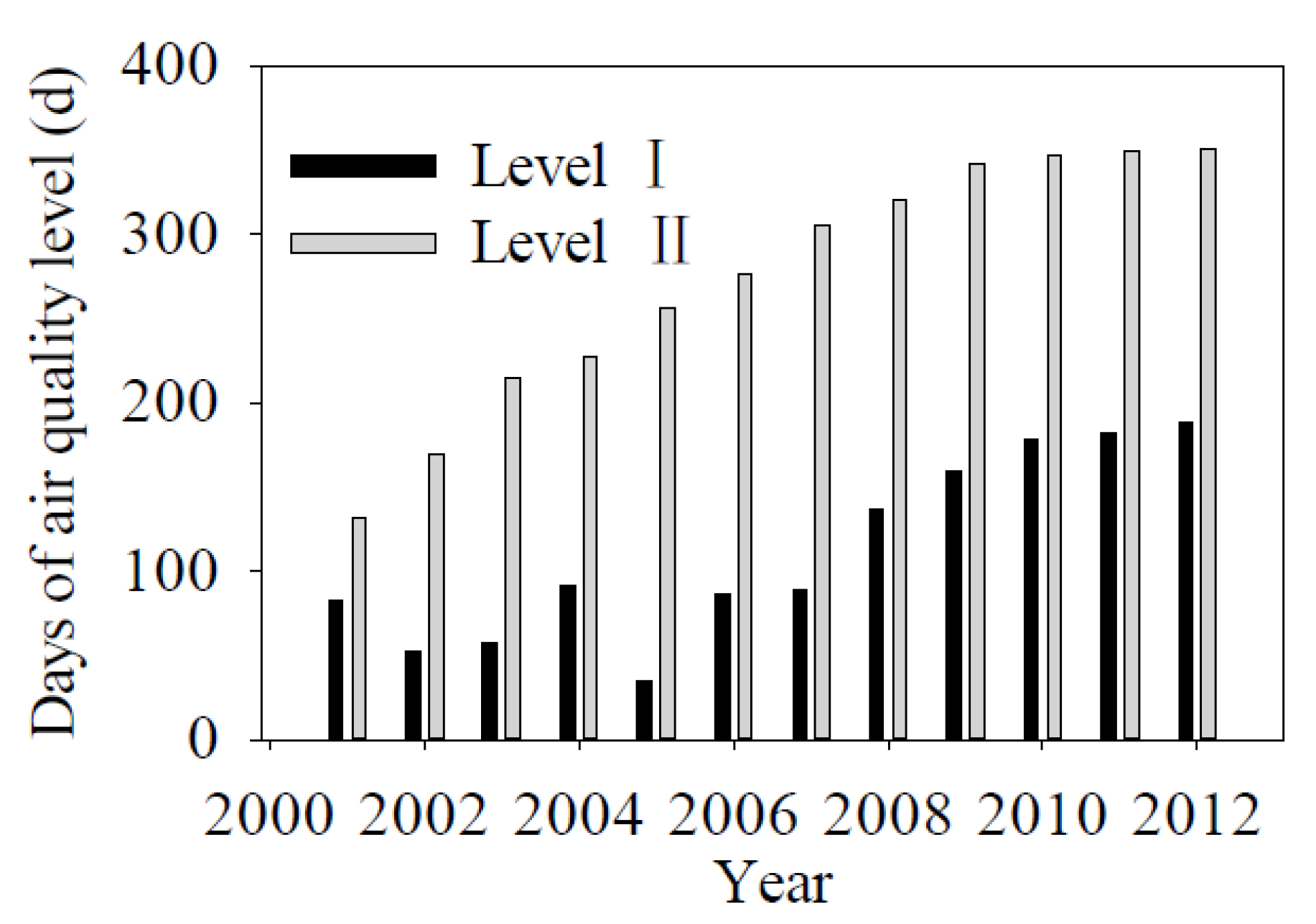
3.5.2. Attribution of Atmospheric Environment Change

3.6. Changes in Vegetation Growth and Attribution
3.6.1. Changes in Vegetation Growth Status
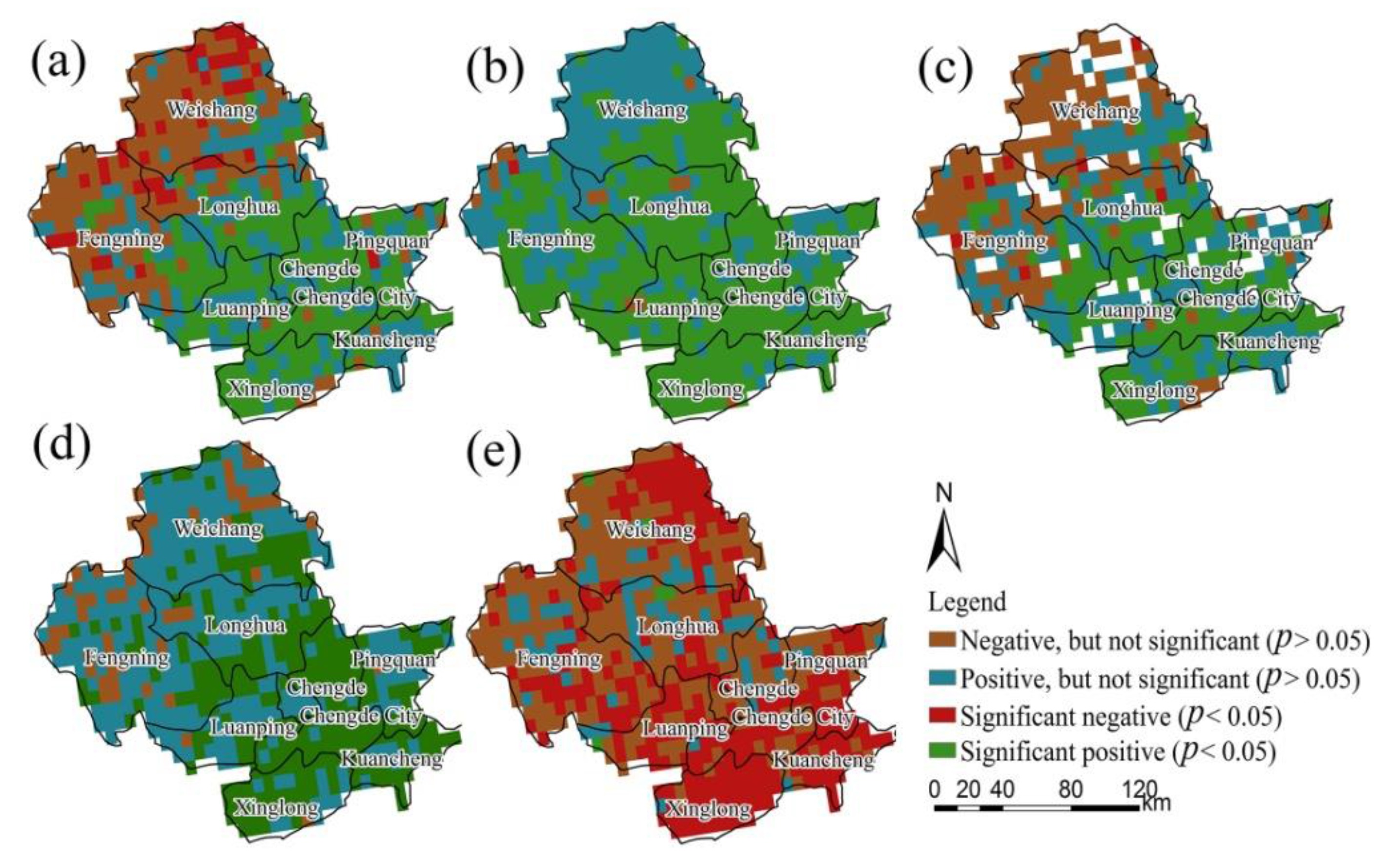
3.6.2. Attribution of Vegetation Growth Status Change
| Change Trends of NDVI | Annual Mean Temperature | Annual Precipitation | Annual Mean Wind Speed | Annual Sunshine Hours |
|---|---|---|---|---|
| Significantly positive trend | 0.125 | 0.396 | −0.165 | 0.196 |
| Significantly negative trend | −0.499 ** | −0.633 ** | −0.201 | 0.253 |
4. Discussion
4.1. Uncertainty in the Water Resources Change Attribution
4.2. Consistency between Local and Regional Vegetation Growth Change
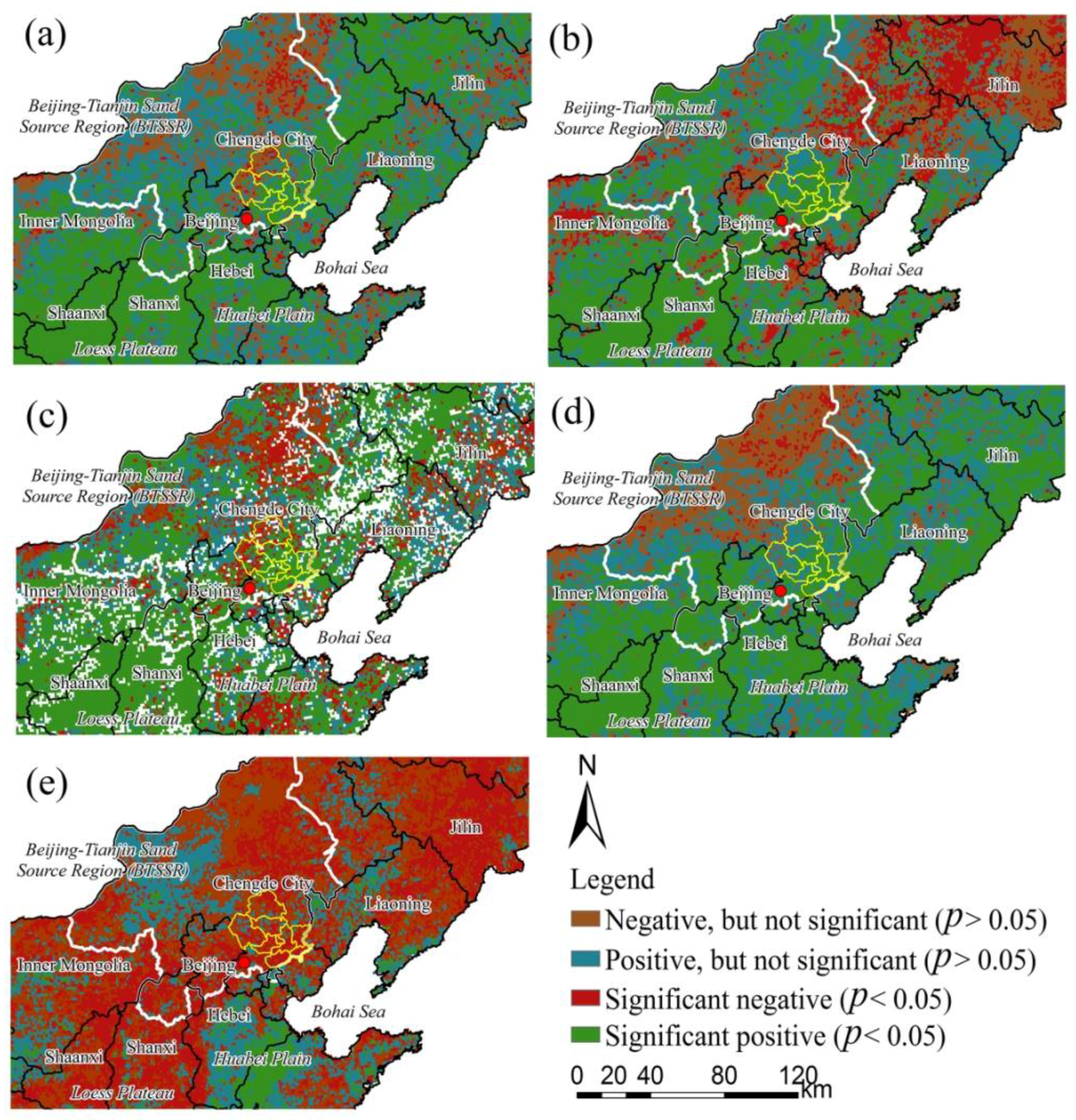
5. Implications of Environmental Change and Ecological Construction
6. Conclusions
- (1)
- In Chengde, the annual mean temperature increased significantly from 1956 to 2011, and the annual precipitation fluctuated severely. The most humid period, 1970–1980, was followed by the driest period in 1980–1990.
- (2)
- The land cover change in 2000–2010 was not obvious. In comparison with 1985 and 2010, the main changes occurred in woodland, farmland, and residential areas, which were caused jointly by ecological projects, urbanization, and population growth.
- (3)
- The streamflow in Chengde presented a downward trend from the late 1950s to 2002, with an abrupt change occurring in 1979. Streamflow reduction was induced jointly by climate variability and human activities, with contributions of 33.2% and 66.8%, respectively.
- (4)
- In the period 2001–2012, clear upward trends were shown in the days of levels I and II air quality. Moreover, the air pollutant concentrations and emissions in Chengde showed relatively low levels compared with those in the adjacent areas and countries or provincial mean levels. That is, the air quality improvement was significantly greater than that in the adjacent areas. The air quality changes were closely related to pollutant emissions induced by anthropogenic activities.
- (5)
- During 1993–2000, the pollutant of MnO4− and volatile phenols at most stations maintained stability. Hardness and NH3-N at more than 50% stations showed upward trends, and the BOD at 70.6% stations showed downward trends, which is a sign of water quality deterioration. The water quality began to improve after 2002, and the water quality above level III at monitoring stations increased significantly. The water quality changes were closely related to pollutant emissions induced by anthropogenic activities.
- (6)
- The changes in vegetation growth in Chengde during 1982–2012 showed obvious spatial heterogeneity. At the annual scale, vegetation in the southeastern and central regions presented restoration trends, and the vegetation in the northwestern area showed a degradation trend. The pixels with obvious degradation trends correlated significantly with the annual mean temperature and annual precipitation. Ecological engineering also played a positive role in the vegetation restoration.
Supplementary Materials
Acknowledgments
Author Contributions
Conflicts of Interest
References
- WMO; UNEP. Climate Change 2013: The Physical Science Basis, Summary for Policymakers. Available online: https://www.ipcc.ch/pdf/assessment-report/ar5/wg1/WGIAR5_SPM_brochure_en.pdf (accessed on 15 January 2016).
- Ji, F.; Wu, Z.H.; Huang, J.P.; Chassignet, E.P. Evolution of land surface air temperature trend. Nat. Clim. Chang. 2014, 4, 462–466. [Google Scholar] [CrossRef]
- Piao, S.L.; Ciais, P.; Huang, Y.; Shen, Z.; Peng, S.; Li, J.; Zhou, L.; Liu, H.; Ma, Y.; Ding, Y.; et al. The impacts of climate change on water resources and agriculture in China. Nature 2010, 467, 43–51. [Google Scholar] [CrossRef] [PubMed]
- Lutz, W.; Samir, K.C. Global human capital: Integrating education and population. Science 2011, 333, 587–592. [Google Scholar] [CrossRef] [PubMed]
- Pimentel, D.; Pimentel, M. Global environmental resources versus world population growth. Ecol. Econ. 2006, 59, 195–198. [Google Scholar] [CrossRef]
- Ellis, E.C.; Ramankutty, N. Putting people in the map: Anthropogenic biomes of the world. Front. Ecol. Environ. 2008, 6, 439–447. [Google Scholar] [CrossRef]
- Mee, L.D.; Dublin, H.T.; Eberhard, A.A. Evaluating the Global Environment Facility: A goodwill gesture or a serious attempt to deliver global benefits? Global Environ. Chang. 2008, 18, 800–810. [Google Scholar] [CrossRef]
- Xu, J.T.; Yin, R.S.; Li, Z. China’s ecological rehabilitation: Unprecedented efforts, dramatic impacts, and requisite polices. Ecol. Econ. 2006, 57, 595–607. [Google Scholar] [CrossRef]
- Lu, Y.H.; Zhang, L.W.; Feng, X.M.; Zeng, Y.; Fu, B.J.; Yao, X.L.; Li, J.R.; Wu, B.F. Recent ecological transitions in China: Greening, browning, and influential factors. Sci. Rep. 2015, 5. [Google Scholar] [CrossRef]
- Shi, Y.F.; Shen, Y.P.; Kang, E.S.; Li, D.L.; Ding, Y.J.; Zhang, G.W.; Hu, R.J. Recent and future climate change in northwest China. Clim. Chang. 2007, 80, 379–393. [Google Scholar] [CrossRef]
- Benayas, J.M.R.; Newton, A.C.; Diaz, A.; Bullock, J.M. Enhancement of biodiversity and ecosystem services by ecological restoration: A meta-analysis. Science 2009, 325, 1121–1124. [Google Scholar] [CrossRef] [PubMed]
- Bullock, J.M.; Aronson, J.; Newton, A.C.; Pywell, R.F.; Rey-Benayas, J.M. Restoration of ecosystem services and biodiversity: Conflicts and opportunities. Trends Ecol. Evol. 2011, 26, 541–549. [Google Scholar] [CrossRef] [PubMed]
- Allan, J.D. Joint analysis of stressors and ecosystem services to enhance restoration effectiveness. Proc. Natl. Acad. Sci. USA 2013, 110, 372–377. [Google Scholar] [CrossRef] [PubMed]
- Ma, T.; Zhou, C.H.; Pei, T. Simulating and estimating tempo-spatial patterns in global human appropriation of net primary production (HANPP): A consumption-based approach. Ecol. Indic. 2012, 23, 660–667. [Google Scholar] [CrossRef]
- Yin, R.S.; Yin, G.P. China’s primary programs of terrestrial ecosystem restoration: Initiation, implementation, and challenges. Environ. Manag. 2010, 45, 429–441. [Google Scholar] [CrossRef] [PubMed]
- Zhang, G.L.; Dong, J.W.; Xiao, X.M.; Hu, Z.; Sheldon, S. Effectiveness of ecological restoration projects in Horqin Sandy Land, China based on SPOT-VGT NDVI data. Ecol. Eng. 2012, 38, 20–29. [Google Scholar] [CrossRef]
- Gao, Z.Q.; Liu, J.Y.; Cao, M.K.; Li, K.R.; Tao, B. The land use and climate changes and their impacts on productivity and carbon cycle of ecosystem in the agro–pastoral transitional zone. Sci. China D 2004, 34, 946–957. [Google Scholar]
- Wu, Z.T.; Wu, J.J.; Liu, J.H.; He, B.; Lei, T.J.; Wang, Q.F. Increasing terrestrial vegetation activity of ecological restoration program in the Beijing–Tianjin sand source region of China. Ecol. Eng. 2013, 52, 37–50. [Google Scholar] [CrossRef]
- The National Geomatics Center of China. Dataset of Administrative Division in China. Available online: http://www.ngcc.cn/ (accessed on 15 January 2016).
- Consultative Group on International Agricultural Research−Consortium for Spatial Information (CGIAR-CSI). What is CGIAR-CSI ? Available online: http://csi.cgiar.org/WhtIsCGIAR_CSI.asp (accessed on 15 January 2016).
- Li, J.Z.; Feng, P. Runoff variations in the Luanhe River Basin during 1956–2002. J. Geogr. Sci. 2007, 17, 339–350. [Google Scholar] [CrossRef]
- Hydrology and Water Resources Survey Bureau of Chengde City. Assessment of Water Resources in Chengde City. Available online: http://wenku.baidu.com/ (accessed on 15 January 2016).
- National Meteorological Data Sharing Service System. Daily Dataset of Climate Data in China. Available online: http://data.cma.gov.cn/ (accessed on 15 January 2016).
- National Aeronautics and Space Administration (NASA). GIMMS 3g. v0. Available online: http://ecocast.arc.nasa.gov/data/pub/gimms/ (accessed on 15 January 2016).
- Data Center for Resources and Environmental Sciences, Chinese Academy of Sciences. Remote Sensing Monitoring Data of Land Use in China. Available online: http://www.resdc.cn/ (accessed on 15 January 2016).
- Hebei Province Environmental Protection Bureau. Hebei Province Environment Condition Bulletin (2000−2012). Available online: http://www.hb12369.net/hjzlzkgb/ (accessed on 15 January 2016).
- Chengde City Environmental Protection Bureau. Chengde City Environment Condition Bulletin (2002−2012). Available online: http://www.cdhb.gov.cn/quality/index.aspx?classid=98/ (accessed on 15 January 2016).
- Liu, J.Y.; Liu, M.L.; Zhang, D.F.; Zhang, Z.X.; Deng, X.Z. Study on spatial pattern of land-use change in China during 1995−2000. Sci. China Ser. D 2003, 46, 1373–1384. [Google Scholar]
- Liu, J.Y.; Liu, M.L.; Tian, H.Q.; Zhang, D.F.; Zhang, Z.X.; Zhang, W.; Tang, X.M.; Deng, X.Z. Spatial and temporal patterns of China's cropland during 1990–2000: An analysis based on Landsat TM data. Remote Sens. Environ. 2005, 98, 442–456. [Google Scholar] [CrossRef]
- Liu, J.Y.; Kuang, W.H.; Zhang, Z.X.; Xu, X.L.; Qin, Y.W.; Ning, J.; Zhou, W.C.; Zhang, S.W.; Li, R.D.; Yan, C.Z.; et al. Spatiao-temporal characteristics, patterns and causes of land-use changes in China since the late 1980s. J. Geogr. Sci. 2014, 24, 195–210. [Google Scholar] [CrossRef]
- Pinzon, J.; Tucker, C. A non-stationary 1981–2012 AVHRR NDVI3g time series. Remote Sens. 2014, 6, 6929–6960. [Google Scholar] [CrossRef]
- Peng, S.; Piao, S.; Ciais, P.; Fang, J.; Wang, X. Change in winter snow depth and its impacts on vegetation in China. Glob. Chang. Biol. 2010, 16, 3004–3013. [Google Scholar] [CrossRef]
- Tucker, C.J.; Pinzon, J.E.; Brown, M.E.; Slayback, D.A.; Pak, E.W.; Mahoney, R.; Vermote, E.F.; Saleous, N. An extended AVHRR 8-km NDVI dataset compatible with MODIS and SPOT vegetation NDVI data. Int. J. Remote Sens. 2005, 26, 4485–4498. [Google Scholar] [CrossRef]
- Hamed, K.H. Trend detection in hydrologic data: The Mann–Kendall trend test under the scaling hypothesis. J. Hydrol. 2008, 349, 350–363. [Google Scholar] [CrossRef]
- Liang, L.Q.; Li, L.J.; Liu, Q. Temporal variation of reference evapotranspiration during 1961–2005 in the Taoer River basin of Northeast China. Agric. For. Meteorol. 2010, 150, 298–306. [Google Scholar] [CrossRef]
- Liu, H.J.; Li, Y.; Josef, T.; Zhang, R.H.; Huang, G.H. Quantitative estimation of climate change effects on potential evapotranspiration in Beijing during 1951–2010. J. Geogr. Sci. 2014, 24, 93–112. [Google Scholar] [CrossRef]
- Du, J.; He, F.; Zhang, Z.; Shi, P. Precipitation change and human impacts on hydrologic variables in Zhengshui River Basin, China. Stoch. Env. Res. Risk A. 2011, 25, 1013–1025. [Google Scholar] [CrossRef]
- Allen, R.G.; Pereira, L.S.; Raes, D.; Martin, S. Crop Evapotranspiration–Guidelines for Computing Crop Water Requirements—FAO Irrigation and Drainage Paper 56. Available online: https://appgeodb.nancy.inra.fr/biljou/pdf/Allen_FAO1998.pdf (accessed on 15 January 2016).
- Koster, R.D.; Suarez, M.J. A simple framework for examining the interannual variability of land surface moisture fluxes. J. Clim. 1999, 12, 1911–1917. [Google Scholar] [CrossRef]
- Milly, P.C.D.; Dunne, K.A. Macroscale water fluxes 2. Water and energy supply control of their inter-annual variability. Water Resour. Res. 2002, 38. [Google Scholar] [CrossRef]
- Amisigo, B.A.; van de Giesen, N.; Rogers, C.; Andah, W.E.I.; Friesen, J. Monthly streamflow prediction in the Volta basin of West Africa: A SISONARMAX polynomial modelling. Phys. Chem. Earth 2008, 33, 141–150. [Google Scholar] [CrossRef]
- Pettitt, A.N. A non-parametric approach to the change-point problem. J. Appl. Stat. 1979, 28, 126–135. [Google Scholar] [CrossRef]
- Zhang, L.; Dawes, W.R.; Walker, G.R. Response of mean annual evapotranspiration to vegetation changes at catchment scale. Water Resour. Res. 2001, 37, 701–708. [Google Scholar] [CrossRef]
- Sun, G.; McNulty, S.G.; Amatya, D.M.; Skaggs, R.W.; Swift, L.W.; Shepard, J.P.; Riekerk, H. A comparison of the hydrology of the coastal forested wetlands/pine flatwoods and the mountainous uplands in the southern US. J. Hydrol. 2002, 263, 92–104. [Google Scholar] [CrossRef]
- Sun, G.; McNulty, S.G.; Lu, J.; Amatya, D.M.; Liang, Y.; Kolka, R.K. Regional annual water yield from forest lands and its response to potential deforestation across the southeastern United States. J. Hydrol. 2005, 308, 258–268. [Google Scholar] [CrossRef]
- Ministry of Environmental Protection of China (MEP). Environmental Quality Standards for Surface Water (GB3838–2002); MEP: Beijing, China, 2002; pp. 1–9. [Google Scholar]
- Ministry of Environmental Protection of China (MEP). Ambient Air Quality Standards (GB 3095–2012); MEP: Beijing, China, 2012; pp. 1–6. [Google Scholar]
- Yao, Q.L.; Lu, G.Q.; Du, J.; Tan, X.Q. Evaluation of ecological benefits from returning land for farming to forestry in Chengde City. J. Agric. Univ. Hebei 2009, 32, 57–61. (In Chinese) [Google Scholar]
- Fu, G.B.; Chen, S.L.; Liu, C.M.; Shepard, D. Hydro-climatic trends of the Yellow River basin for the last 50 years. Clim. Chang. 2004, 65, 149–178. [Google Scholar] [CrossRef]
- Bao, Z.X.; Zhang, J.Y.; Wang, G.Q.; Fu, G.B.; He, R.M.; Yan, X.L.; Jin, J.L.; Liu, Y.L.; Zhang, A.J. Attribution for decreasing streamflow of the Haihe River basin, northern China: climate variability or human activities? J. Hydrol. 2012, 460–461, 117–129. [Google Scholar] [CrossRef]
- Wang, W.; Shao, Q.; Yang, T.; Peng, S.; Xing, W.; Sun, F.; Luo, Y. Quantitative assessment of the impact of climate variability and human activities on runoff changes: A case study in four catchments of the Haihe River basin, China. Hydrol. Process. 2013, 27, 1158–1174. [Google Scholar] [CrossRef]
- Liu, X.F.; Zhu, X.F.; Pan, Y.Z.; Li, Y.Z.; Zhao, A.Z. Spatiotemporal changes in vegetation coverage in China during 1982–2012. Acta Ecol. Sin. 2015, 35, 5331–5342. [Google Scholar]
- Qu, B.; Zhu, W.B.; Jia, S.F.; Lv, A.F. Spatio-temporal changes in vegetation activity and its driving factors during the growing season in China from 1982 to 2011. Remote Sens. 2015, 7, 13729–13752. [Google Scholar] [CrossRef]
- Zhang, Y.; Peng, C.H.; Li, W.Z.; Tian, L.X.; Zhu, Q.A.; Chen, H.; Fang, X.Q.; Zhang, G.L.; Liu, G.B.; Mu, X.M.; et al. Multiple afforestation programs accelerate the greenness in the “Three North” region of China from 1982 to 2013. Ecol. Indicat. 2015, 61, 404–412. [Google Scholar] [CrossRef]
© 2016 by the authors; licensee MDPI, Basel, Switzerland. This article is an open access article distributed under the terms and conditions of the Creative Commons by Attribution (CC-BY) license (http://creativecommons.org/licenses/by/4.0/).
Share and Cite
Jiang, C.; Wang, F. Environmental Change in the Agro-Pastoral Transitional Zone, Northern China: Patterns, Drivers, and Implications. Int. J. Environ. Res. Public Health 2016, 13, 165. https://doi.org/10.3390/ijerph13020165
Jiang C, Wang F. Environmental Change in the Agro-Pastoral Transitional Zone, Northern China: Patterns, Drivers, and Implications. International Journal of Environmental Research and Public Health. 2016; 13(2):165. https://doi.org/10.3390/ijerph13020165
Chicago/Turabian StyleJiang, Chong, and Fei Wang. 2016. "Environmental Change in the Agro-Pastoral Transitional Zone, Northern China: Patterns, Drivers, and Implications" International Journal of Environmental Research and Public Health 13, no. 2: 165. https://doi.org/10.3390/ijerph13020165
APA StyleJiang, C., & Wang, F. (2016). Environmental Change in the Agro-Pastoral Transitional Zone, Northern China: Patterns, Drivers, and Implications. International Journal of Environmental Research and Public Health, 13(2), 165. https://doi.org/10.3390/ijerph13020165







